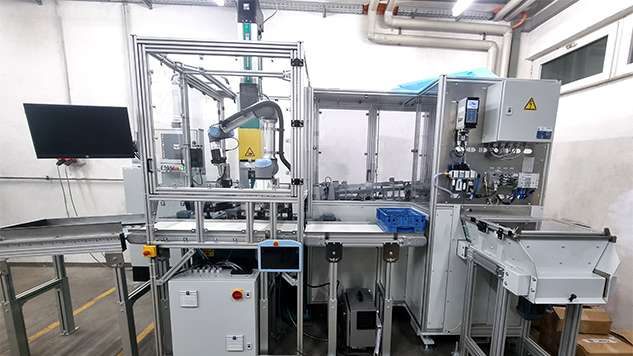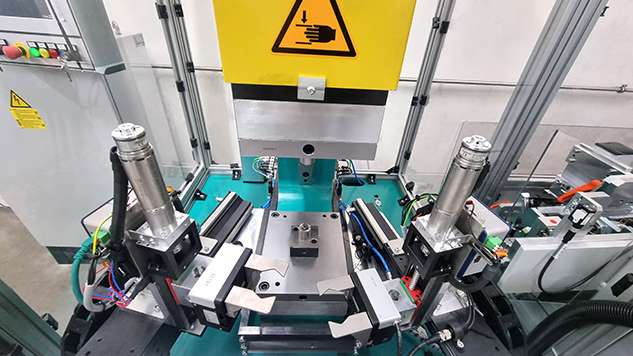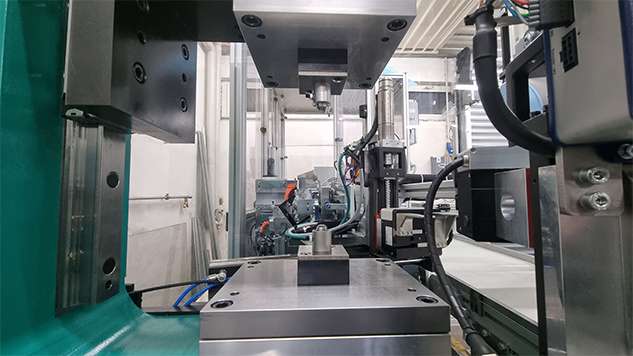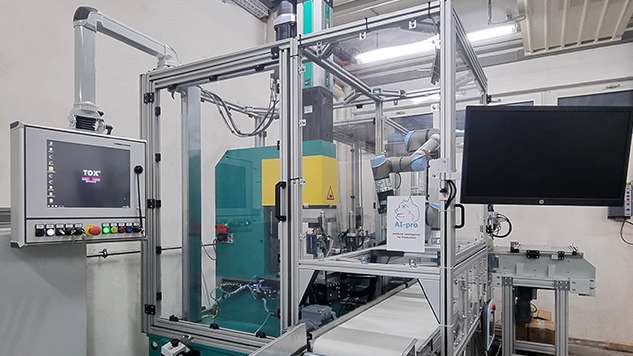Automation of the loading and unloading of machines increases efficiency in production – particularly if the subsequent manual visual inspection is also automated. AI-pro develops individual solutions for this purpose and complements machines such as the servo press from TOX® PRESSOTECHNIK with robots and artificial intelligence.
“The biggest potential can be found in smaller products, larger quantities and shorter clock times”, says Pascal Lettmann, Managing Director and company founder of AI-pro UG. In the industrial environment he has often observed how workers insert small parts into machines and remove them in short clock times. This is a repetitive task, which can be automated relatively easily – compared to the subsequent manual visual inspection. “From a technological point of view, it is difficult to replace the operator's scrutiny when removing the parts with rule-based camera control systems, which is often associated with high costs”, says Mr. Lettmann. The system quickly reaches its limit, for example due to fluctuating light conditions or geometrical deviations. Furthermore, such camera systems must be operated by specifically trained staff, passing on the effort and at the same time responsibility for the detection of faulty products to the user.
This is precisely where AI-pro comes into play, providing visual inspection and automation from one source. “We solely focus on manageable processes, such as insertion into and removal of small components from machines with short clock times, and complement these with reliable test technology including programming”, says the company founder. What is special here: The start-up from North Rhine-Westphalia in Germany purchases the system to be automated and complements it with the required handling, control and inspection technology. “Our customers are not faced with lengthy setup of testing programs or with communication programs between robot and machine”, says Mr. Lettmann citing the benefits. He will explain later how he manages to automate the otherwise costly visual inspection.
First of all, he will provide an insight into one of his current projects: A customer wanted to renew manually operated hydraulic presses for the compression of ball sleeves, and automate the process in this context. The machines used so far have no sensors for detecting defective parts, the sleeves kept getting stuck in the tools after pressing, and the maintenance costs of the hydraulics were too high.
Stability and control
AI-pro was looking for a stable press with servo drive for the actual work process, which enables a short clock time, measures the press-in depth X and monitors the process as a result. As soon as the X value is exceeded or undercut, the system is expected to detect the faulty part and reject it. Following extensive research, Mr. Lettmann decided on a C-frame press from TOX® PRESSOTECHNIK GmbH & Co. KG. Mr. Lettmann gained good experience with the family business from Weingarten in the past already. “The comprehensive consultation beforehand, and the offer with the standard construction kit reinforced my decision to purchase the press from TOX®”, says Mr. Lettmann.
The TOX®-ElectricDrive of type EX-K is used as the drive. A planetary threaded spindle accurately converts the rotation movement to a linear feed, which presses the tool into the component with up to 200 kilonewton. It is installed in a solid and torsion-resistant steel structure, which meets the force application with sufficient stability during the pressing process. As soon as a ball sleeve is positioned in the tool, the drive moves the ram downwards. A resolver measures the path required for the force-path protocol directly on the servo drive, an integrated force gauge contributes the press force needed for this. The TOX®-Software monitors the control value X and can detect any faulty parts immediately.
AI-pro added two linear-guided grippers to the TOX®-Servo Press, which insert a component into the tool alternately, fix it after pressing and before the punch moves up again and remove it afterwards. They then hold the component to the lightweight robot again, which accepts it with the inner handle and passes it on. AI-pro significantly reduces the idle times with the alternating functioning of the two feed units. “So the robot alternately takes the completed component from one or the other unit”, Mr. Lettmann explains. Following more processing, seven cameras and one micrometer check the completed ball sleeve visually and geometrically. AI-pro uses neural networks for this purpose: “With them, our inspection system securely detects grooves, chamfers and chatter marks – even on reflective surfaces. The inspection of certain characteristics or alignment is also possible”, says Mr. Lettmann. This works by means of classifications, finding similarities on pixel level and is only possible for AI-based visual inspection through the availability of respective computing power, which also makes sense from a cost perspective. AI-pro selects all components individually: from the camera and lighting to feeding and algorithms for visual inspection. “In the end, all the customer is left to do is press a button“, says Pascal Lettmann.
No issues on the interface
Communication between robot and press occurs via the higher control by means of Profinet. The pressing process itself is initially configured once, or in case of a part replacement via the TOX®-HMI, maintenance also occurs via the TOX®-Panel. The AI-pro automation then issues the start and stop signal, and also responds to fluctuations in the process. “Our system simply scans the data of the TOX®-Software, which it sends to the PLC”, Mr. Lettmann explains. The robot also requests the last measured values for quality control and knows whether the completed component is to be placed in the IO or NIO box. Furthermore, AI-pro can send these process data to its AI computer, for example about approved and reject parts, which then stores these data in an SQL database. “Normally, the data exchange from the PLC to higher control systems such as ERPs is relatively difficult. But our computer speaks precisely these languages”, says Mr. Lettmann.
The signal exchange between press, robot and the remaining automation works seamlessly. One reason for this is the good communication beforehand: “TOX® PRESSOTECHNIK has advised on communication options with the press and provided us with the complete documentation on this early on in the course of the project. Therefore, we had no interface issues whatsoever”, Mr. Lettmann confirms.





























